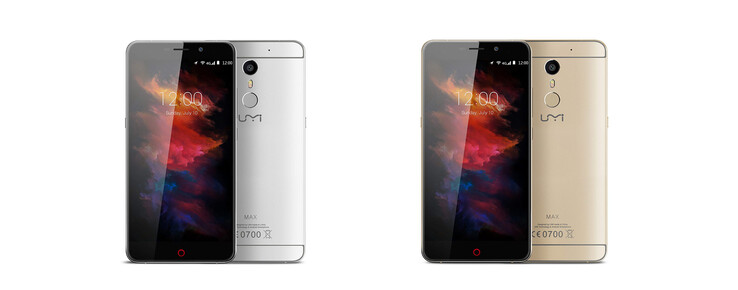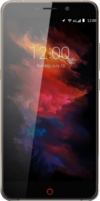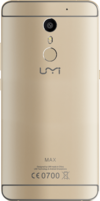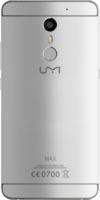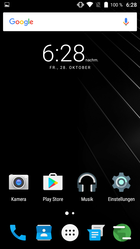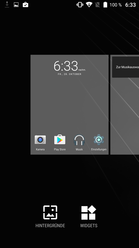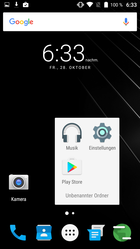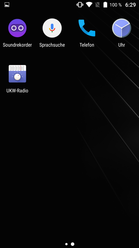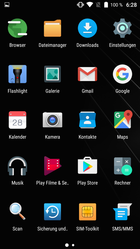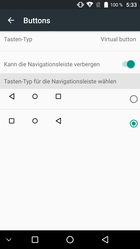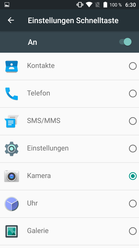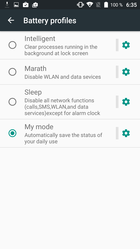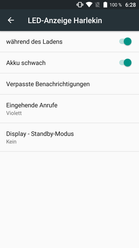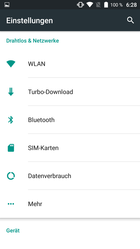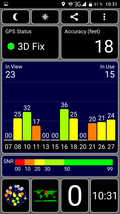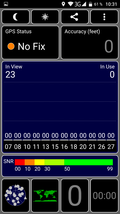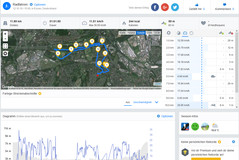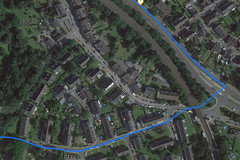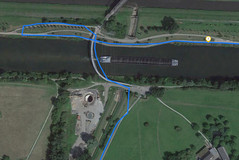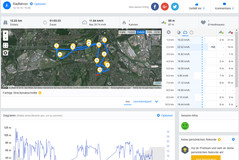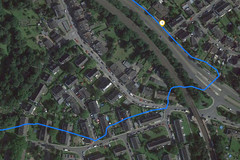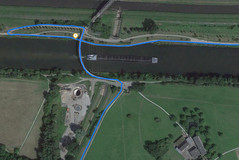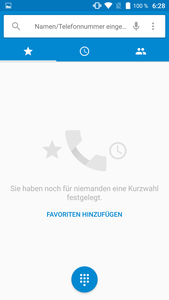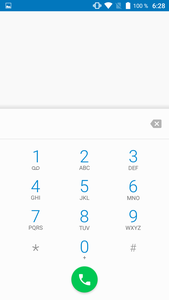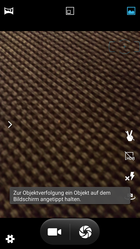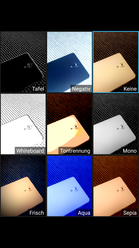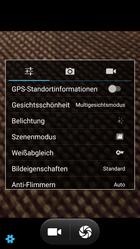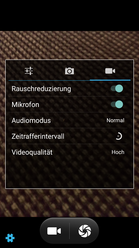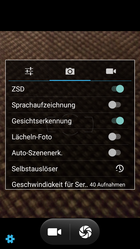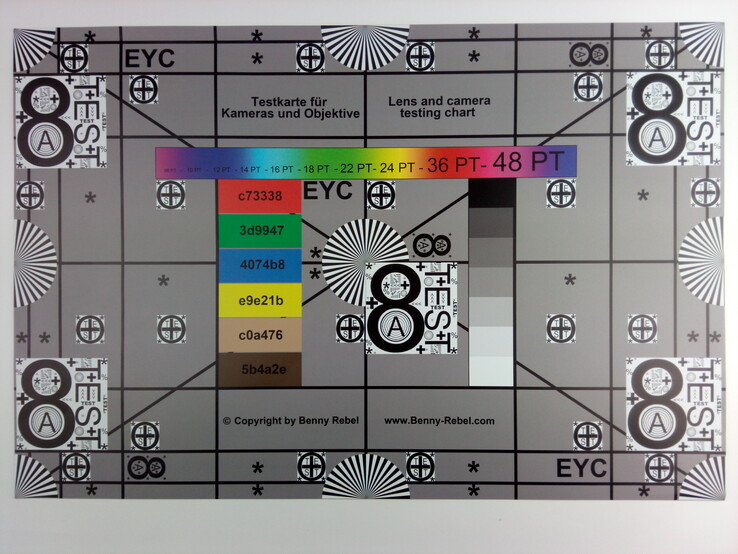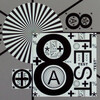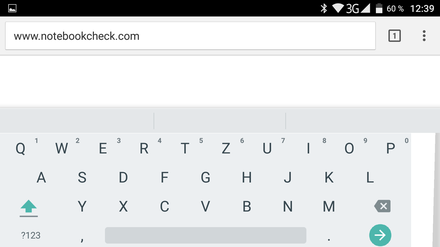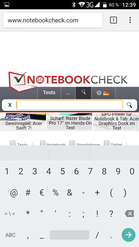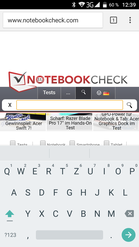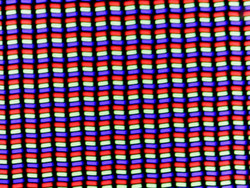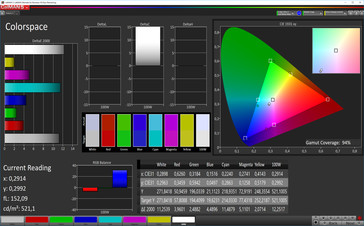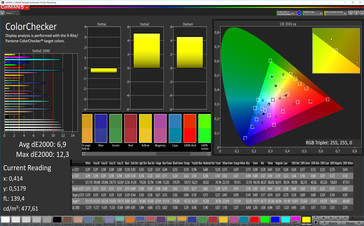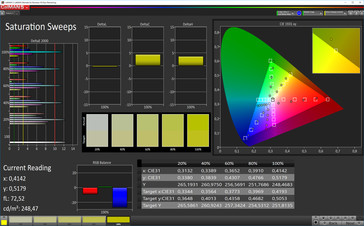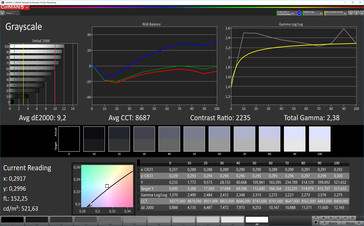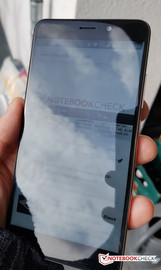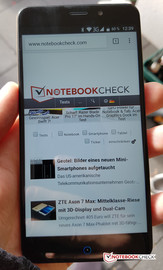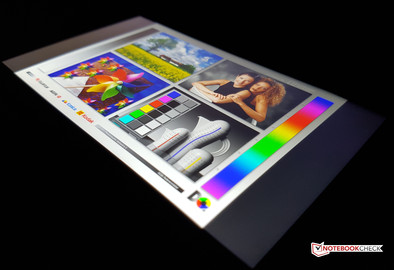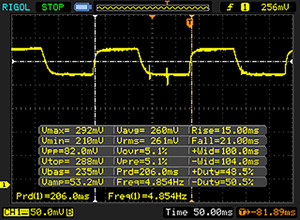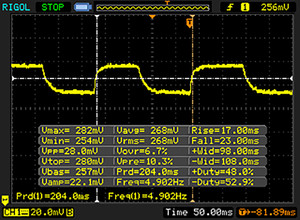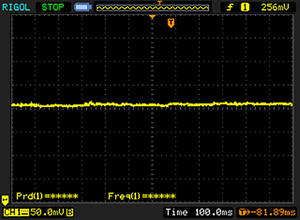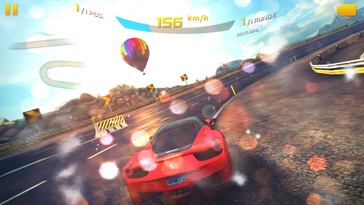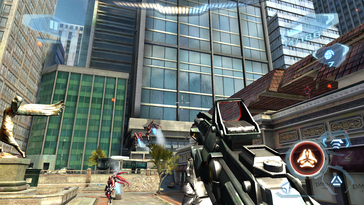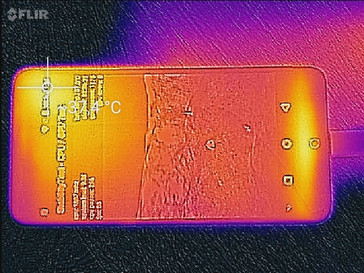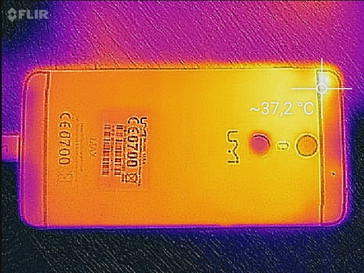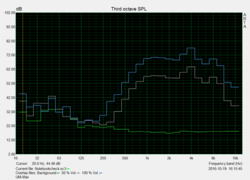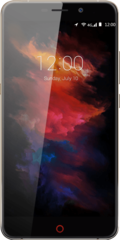UMi Max Smartphone Review
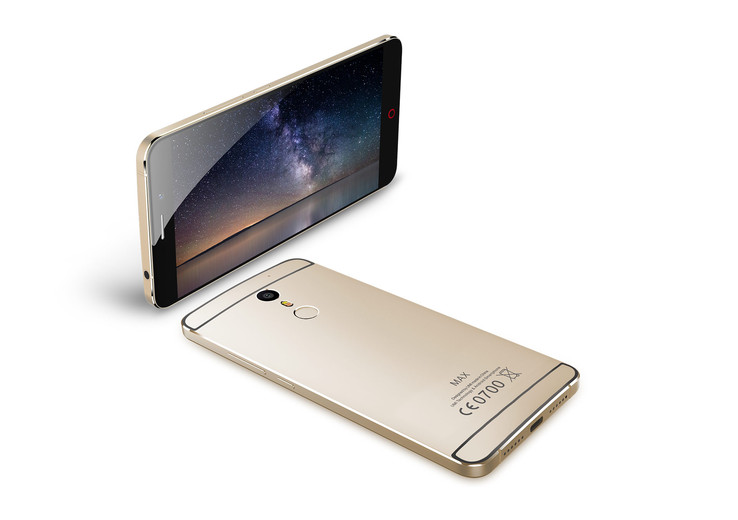
For the original German review, see here.
Purely from the technical specifications, it seems that the UMi Max is offering a lot for 150 Euros (~$160/including shipping) via importers. In contrast to the low price, the technical specifications of the 5.5-inch smartphone put it in the upper middle class. The smartphone is equipped with a full HD resolution (1080p) display, a MediaTek Helio-P10 processor, 3 GB RAM, 16 GB flash memory, a 13 MP main camera, a 4,000 mAh battery and an aluminum unibody. The device even has a fingerprint sensor on the back. Although the UMi Max is not planned for the German market, it does support the primary German LTE frequencies.
The entry-level smartphone segment has a lot of competition: we will be comparing our test model with the ZTE Blade V7 Lite, the Blackview R7, the Acer Liquid Z630S, the Leagoo Shark 1, the Coolpad Torino S and the more expensive Honor 5C (190 Euros/~$202). The similarly equipped UMi models "Touch" and "Super" are also worth considering, as they cost about 140 and 170 Euros (~$149 and $181) respectively.
Case
The UMi Max aluminum unibody is available in gray (Gunmetal Gray) and gold (Bling Gold). The case is rounded on the sides and feels very nice in the hand. However, in some parts, like the edges where the back and the metal frame meet, the materials need to be polished further. The manufacturer has successfully used synthetic material to cover the antennas on the upper and lower back of the device. In contrast, their use of plastic material in certain areas of the metal borders or the SIM card slot is poor, as it sticks out from the rest of the case.
The controls for the volume and the power button on the right side of the device have a good finish as they sit well in the case. There is room for improvement as the pressure points should be less spongy. A special feature of the UMi Max can be found on the left side of the case: the so-called Smart key is a quick-start button that can be individually customized.
The front of the display is protected by a slightly rounded 2.5D glass of Corning Gorilla Glass 3. The borders around the IPS panel are relatively small. The display measures 151 x 75 mm (~6 x 3 in) and the screen is 5.5 inches diagonally. This results in a display-surface ratio of 73.7%.
Overall, we like the case stability as nothing creaked in our hands.
Connectivity
The internal eMMC memory, which can be increased with a microSD card (up to 256 GB), is generously sized at 16 GB. The user can use approximately 10.4 GB (ROM) memory, due to the OS installation. In addition, the microSD card can be integrated into the internal memory via formatting and compatible apps can be transferred to the memory card (App2SD).
UMi Max only supports the USB 2.0 standard, even though it has the modern USB Type C connector on the base of the device. OTG adapters can be used to connect nearby devices, such as external keyboards or USB sticks.
The new features of the entry-level mobile phone include: an integrated FM radio, dual SIM functionality, Miracast, a fingerprint sensor and an LED light for notification inputs, which is integrated in the touch-sensitive Home button and can be permanently activated.
Software
UMi uses the sixth Android iteration, "Marshmallow", for its smartphone model Max. At the time of testing, the security patch was of May 2016. UMi has already announced a system update to Android 7 planned for this year - a rare offering for a device of this price class.
Although the system has a UMi user interface, it looks quite similar to Vanilla Android and maintains basic structures. However, the user interface in the settings and the home screen have been visually and functionally tweaked.
Communication and GPS
The UMi Max uses Bluetooth version 4.1, in order to have wireless communication between mobile devices. The manufacturer has omitted the installation of an NFC chip. In addition, this mobile phone supports the use of two microSIM cards. According to UMi, both slots support the LTE mobile standard (Cat.4) for up to 150 Mbps downlink and 50 Mbps upstream and all German frequencies, but they cannot be used simultaneously. In Dual SIM mode, a slot is limited to the 2G network. Only one slot supported the LTE standard in single-SIM operation.
The WLAN complies with the IEEE-802.11 standards according to a/b/g/n. The reception performance is good and the WLAN signal is stable for everyday use. In proximity of the router (Telekom Speedport, W921V), the attenuation is low with -36 dBm. From a distance of 1 meter (~3 feet), the average rates of data transmission to our reference router (Linksys EA8500) are very satisfactory, with values of 103 Mbps (transmitted) and 99 Mbps (received).
| Networking | |
| iperf3 transmit AX12 | |
| UMI Max | |
| iperf3 receive AX12 | |
| UMI Max | |
| iperf Server (receive) TCP 1 m | |
| Lenovo Moto Z | |
| UMI Super Euro Edition | |
| Blackview R7 | |
| Honor 5C | |
| iperf Client (transmit) TCP 1 m | |
| Lenovo Moto Z | |
| UMI Super Euro Edition | |
| Blackview R7 | |
| Honor 5C | |
In order to determine the position of UMi Max, a GPS satellite system is used. Outdoors locations are detected without any delays, though the system is only accurate up to 5.5 meters (~18 ft). Is not possible to determine the location of the device inside buildings. On a 12 km (7.5 miles) long test track, our smartphone GPS had a deviation of about 340 m (~0.2 miles) compared to the professional Navi Garmin Edge 500. The location accuracy of the professional navigation device is higher overall, whereas the UMi Max accuracy reflects its price, which is acceptable.
Phone Features and Voice Quality
The voice quality is average, which is acceptable considering that the test model is an entry-level phone. During our test calls, it was possible to have a clear conversation with the call recipient. The quality of the in-built microphone is satisfactory. The voice of our conversation partner was generally clear, but with some reverberation.
The phone app is very similar to the standard Google phone app from Android 6.0.
Cameras
UMi has installed a 13-MP camera on the back. This camera is a Panasonic sensor (MN34152) with autofocus and two-color LED flash. The lens aperture is f / 2.0. The quality of the photos is satisfactory for an entry-level device. However, taking photos might be difficult due to the low sharpness (especially at the edges) and the pictures might appear a little pale (scene 1: boat). In order to capture sharper photos, one should change the settings manually from "Normal" to "High". The dynamics of the bright and dark regions of the photos are on a good level. However, bright regions of the images tend to be over-exposed. In poor lighting conditions, photos have low sharpness and can end up blurred, but the UMi Max still produces brighter images than other smartphones of this price class (scene 3: road).
On the front, a 5 MP camera is installed with an image sensor from Samsung (GalaxyCore GC5005). This camera takes good quality selfies. The UMi smartphone records videos with a maximum 1080p at a frame rate of 30 FPS. If the 5 MP front camera is being used, the video resolution is reduced to 720p at 30 FPS.
Accessories and Warranty
The UMi Max package includes a modular power supply of 5 watts (5 volts, 1 amp) and a USB cable. As an optional accessory, the manufacturer offers a special ClearCase, Flip Cover and a resistant screen case for the phone.
UMi offers a 12-month warranty on its smartphone. Information to consider when purchasing smartphones via import companies can be found here.
Input Devices and Operation
The smartphone is controlled via the three Android-typical on-screen or touch-sensitive buttons below the display. Except for the Home button, these buttons are not illuminated. The keys, "Back" and "Multitasking", can be customized by the user.
The capacitive multi-touch screen (5 fingers) works well. Input is precisely recognized and executed without delays. The active fingerprint sensor on the back of the case is positioned well and unlocks the device using biometric fingerprint identification, which is reliable, although the finger may not always be recognized on the first try.
The stock Android keyboard is preinstalled by Google as a text input option.
Display
The 5.5-inch IPS-LC display from Sharp (Sunlight Screen) offers a resolution of 1920x1080 pixels, which is quite high as the content is displayed with a pixel density of 401 ppi (quite sharp). The maximum luminosity of the IPS panel of 537 cd/m² is very good for a device of this price class. The APL50 test shows a luminosity of 417 cd/m² for the centre of the screen, which is a clear deviation compared to the maximum brightness. Measurement of the maximum luminosity with activated brightness sensor also results in lower values (499 cd/m²).
| |||||||||||||||||||||||||
Brightness Distribution: 86 %
Center on Battery: 522 cd/m²
Contrast: 2270:1 (Black: 0.23 cd/m²)
ΔE ColorChecker Calman: 6.9 | ∀{0.5-29.43 Ø4.77}
ΔE Greyscale Calman: 9.2 | ∀{0.09-98 Ø5}
Gamma: 2.38
CCT: 8687 K
| UMI Max IPS, 1920x1080, 5.5" | UMI Touch IPS, 1920x1080, 5.5" | Coolpad Torino S IPS, 1280x720, 4.7" | ZTE Blade V7 Lite IPS, 1280x720, 5" | Blackview R7 IPS, 1920x1080, 5.5" | Acer Liquid Z630S IPS, 1280x720, 5.5" | Leagoo Shark 1 IPS, 1920x1080, 6" | UMI Super Euro Edition IPS, 1920x1080, 5.5" | Honor 5C IPS, 1920x1080, 5.2" | |
|---|---|---|---|---|---|---|---|---|---|
| Screen | -24% | -22% | -14% | -51% | -3% | -52% | 4% | -15% | |
| Brightness middle (cd/m²) | 522 | 424 -19% | 360 -31% | 312 -40% | 552 6% | 350 -33% | 471 -10% | 418 -20% | 515 -1% |
| Brightness (cd/m²) | 498 | 415 -17% | 358 -28% | 302 -39% | 526 6% | 345 -31% | 465 -7% | 410 -18% | 498 0% |
| Brightness Distribution (%) | 86 | 91 6% | 87 1% | 79 -8% | 91 6% | 84 -2% | 82 -5% | 85 -1% | 93 8% |
| Black Level * (cd/m²) | 0.23 | 0.54 -135% | 0.45 -96% | 0.15 35% | 0.64 -178% | 0.27 -17% | 0.9 -291% | 0.31 -35% | 0.49 -113% |
| Contrast (:1) | 2270 | 785 -65% | 800 -65% | 2080 -8% | 863 -62% | 1296 -43% | 523 -77% | 1348 -41% | 1051 -54% |
| Colorchecker dE 2000 * | 6.9 | 6.9 -0% | 6.8 1% | 8.2 -19% | 11 -59% | 4.7 32% | 7.1 -3% | 4.4 36% | 6.2 10% |
| Colorchecker dE 2000 max. * | 12.3 | 10.9 11% | 11.3 8% | 16.5 -34% | 20.8 -69% | 8.5 31% | 17 -38% | 6.5 47% | 11.4 7% |
| Greyscale dE 2000 * | 9.2 | 6.8 26% | 6.2 33% | 9.2 -0% | 14.3 -55% | 5.6 39% | 7.5 18% | 3.6 61% | 7.4 20% |
| Gamma | 2.38 92% | 1.99 111% | 2.14 103% | 2.29 96% | 2.21 100% | 1.84 120% | 2.23 99% | 2.36 93% | 2.28 96% |
| CCT | 8687 75% | 8131 80% | 7975 82% | 9017 72% | 12996 50% | 6795 96% | 8261 79% | 6993 93% | 8664 75% |
* ... smaller is better
The interplay of display luminosity and low black value of 0.22 cd / m² gives a very good contrast ratio of 1: 2,270. The APL50 test, which is most realistic, results in an excellent contrast of 1: 1,813 (black value 0.23 cd / m²) for the price class. The analysis performed with a photo-spectrometer and the CalMAN software shows in part significant deviations in the color (6,9) and the gray balance (9,2). In addition, the color temperature of 8,687 Kelvin is too cool, which results in a slight blue tinge.
In strong ambient lighting, the UMi Max works well thanks to its bright LC display and stays legible even outdoors. Thanks to the IPS technology, the liquid crystal display has very stable viewing angles. Even at extreme viewing angles, no color distortions occur.
Display Response Times
| ↔ Response Time Black to White | ||
|---|---|---|
| 36 ms ... rise ↗ and fall ↘ combined | ↗ 15 ms rise | |
| ↘ 21 ms fall | ||
| The screen shows slow response rates in our tests and will be unsatisfactory for gamers. In comparison, all tested devices range from 0.1 (minimum) to 240 (maximum) ms. » 93 % of all devices are better. This means that the measured response time is worse than the average of all tested devices (20.2 ms). | ||
| ↔ Response Time 50% Grey to 80% Grey | ||
| 40 ms ... rise ↗ and fall ↘ combined | ↗ 17 ms rise | |
| ↘ 23 ms fall | ||
| The screen shows slow response rates in our tests and will be unsatisfactory for gamers. In comparison, all tested devices range from 0.165 (minimum) to 636 (maximum) ms. » 60 % of all devices are better. This means that the measured response time is worse than the average of all tested devices (31.6 ms). | ||
Screen Flickering / PWM (Pulse-Width Modulation)
| Screen flickering / PWM not detected | |||
In comparison: 53 % of all tested devices do not use PWM to dim the display. If PWM was detected, an average of 8081 (minimum: 5 - maximum: 343500) Hz was measured. | |||
Performance
UMi Max is powered by a middle-class 2015 ARM-SoC (system-on-chip) from MediaTek. The MT6755 Helio P10 is manufactured in 28 nanometers and has eight CPU cores based on the 64-bit Cortex-A53 architecture. Thanks to the 3 GB of RAM, our test model was able to compete at the same level as the Helio P10 comparison devices and the Honor 5C, which was slightly faster. In the graphics and browser tests, the test model performs similarly to the processor benchmarks.
The performance of the internal 16 GB memory is at a good level for linear read and write speeds. Transfer rates from the integrated MicroSD reader are slow at just 37 MB/s read and 18 MB/s write with our Toshbia Exceria Pro M401 test card.
The benchmark results match the subjective experience of the UMi smartphone. The fast memory combined with the powerful Helio-P10 processor ensures smooth performance. Moreover, browsing with Chrome works without major delays.
| AnTuTu v6 - Total Score (sort by value) | |
| UMI Max | |
| UMI Touch | |
| Coolpad Torino S | |
| ZTE Blade V7 Lite | |
| Blackview R7 | |
| Acer Liquid Z630S | |
| Leagoo Shark 1 | |
| UMI Super Euro Edition | |
| Honor 5C | |
| Lenovo Moto Z | |
| Geekbench 3 | |
| 64 Bit Single-Core Score (sort by value) | |
| UMI Touch | |
| Coolpad Torino S | |
| ZTE Blade V7 Lite | |
| Honor 5C | |
| Lenovo Moto Z | |
| 64 Bit Multi-Core Score (sort by value) | |
| UMI Touch | |
| Coolpad Torino S | |
| ZTE Blade V7 Lite | |
| Honor 5C | |
| Lenovo Moto Z | |
| Geekbench 4.0 | |
| 64 Bit Multi-Core Score (sort by value) | |
| UMI Max | |
| Blackview R7 | |
| UMI Super Euro Edition | |
| Lenovo Moto Z | |
| 64 Bit Single-Core Score (sort by value) | |
| UMI Max | |
| Blackview R7 | |
| UMI Super Euro Edition | |
| Lenovo Moto Z | |
| GFXBench 3.0 | |
| on screen Manhattan Onscreen OGL (sort by value) | |
| UMI Max | |
| UMI Touch | |
| Coolpad Torino S | |
| ZTE Blade V7 Lite | |
| Blackview R7 | |
| Acer Liquid Z630S | |
| Leagoo Shark 1 | |
| UMI Super Euro Edition | |
| Honor 5C | |
| Lenovo Moto Z | |
| 1920x1080 1080p Manhattan Offscreen (sort by value) | |
| UMI Max | |
| UMI Touch | |
| Coolpad Torino S | |
| ZTE Blade V7 Lite | |
| Blackview R7 | |
| Acer Liquid Z630S | |
| Leagoo Shark 1 | |
| UMI Super Euro Edition | |
| Honor 5C | |
| Lenovo Moto Z | |
| GFXBench 3.1 | |
| on screen Manhattan ES 3.1 Onscreen (sort by value) | |
| UMI Max | |
| UMI Touch | |
| ZTE Blade V7 Lite | |
| Blackview R7 | |
| Leagoo Shark 1 | |
| UMI Super Euro Edition | |
| Honor 5C | |
| Lenovo Moto Z | |
| 1920x1080 Manhattan ES 3.1 Offscreen (sort by value) | |
| UMI Max | |
| UMI Touch | |
| ZTE Blade V7 Lite | |
| Blackview R7 | |
| Leagoo Shark 1 | |
| UMI Super Euro Edition | |
| Honor 5C | |
| Lenovo Moto Z | |
| PCMark for Android - Work performance score (sort by value) | |
| UMI Max | |
| UMI Touch | |
| Coolpad Torino S | |
| Blackview R7 | |
| Acer Liquid Z630S | |
| Leagoo Shark 1 | |
| UMI Super Euro Edition | |
| Honor 5C | |
| Lenovo Moto Z | |
| JetStream 1.1 - Total Score (sort by value) | |
| UMI Max | |
| UMI Touch | |
| Coolpad Torino S | |
| ZTE Blade V7 Lite | |
| Blackview R7 | |
| Acer Liquid Z630S | |
| Leagoo Shark 1 | |
| UMI Super Euro Edition | |
| Honor 5C | |
| Lenovo Moto Z | |
| Mozilla Kraken 1.1 - Total (sort by value) | |
| UMI Max | |
| UMI Touch | |
| Coolpad Torino S | |
| ZTE Blade V7 Lite | |
| Blackview R7 | |
| Acer Liquid Z630S | |
| Leagoo Shark 1 | |
| UMI Super Euro Edition | |
| Honor 5C | |
| Lenovo Moto Z | |
| Octane V2 - Total Score (sort by value) | |
| UMI Max | |
| UMI Touch | |
| Coolpad Torino S | |
| ZTE Blade V7 Lite | |
| Blackview R7 | |
| Acer Liquid Z630S | |
| Leagoo Shark 1 | |
| UMI Super Euro Edition | |
| Honor 5C | |
| Lenovo Moto Z | |
* ... smaller is better
Games
The graphics unit (ARM Mali T860 MP2) integrated in the MediaTek Helio-P10 SoC has two clusters, which clock at up to 700 MHz. Current games of the Android Play Store like N.O.V.A. 3 or Asphalt 8 Airborn run smoothly on the Mali GPU. In our play test, the touch screen reacted quickly and accurately.
Emissions
(±) The maximum temperature on the upper side is 40.2 °C / 104 F, compared to the average of 35.2 °C / 95 F, ranging from 21.9 to 247 °C for the class Smartphone.
(+) The bottom heats up to a maximum of 36.3 °C / 97 F, compared to the average of 34 °C / 93 F
(+) In idle usage, the average temperature for the upper side is 31 °C / 88 F, compared to the device average of 32.9 °C / 91 F.
Speakers
The speakers, which are placed at the base of the device, have a maximum volume of 82 dB(A). This means the phone is sufficiently loud for everyday use and can match the offering of the competition. The sound quality is good for the price class and, even at full volume, the playback is hardly distorted. However, the sound output is not very linear in the audible range and bass is not noticeable. The two competitors, the UMi Touch and the ZTE Blade V7 Lite, perform better.
UMI Max audio analysis
(+) | speakers can play relatively loud (82.4 dB)
Bass 100 - 315 Hz
(-) | nearly no bass - on average 35.9% lower than median
(±) | linearity of bass is average (10.1% delta to prev. frequency)
Mids 400 - 2000 Hz
(±) | reduced mids - on average 7.4% lower than median
(±) | linearity of mids is average (8.7% delta to prev. frequency)
Highs 2 - 16 kHz
(±) | higher highs - on average 5% higher than median
(±) | linearity of highs is average (8.9% delta to prev. frequency)
Overall 100 - 16.000 Hz
(-) | overall sound is not linear (31.8% difference to median)
Compared to same class
» 82% of all tested devices in this class were better, 2% similar, 16% worse
» The best had a delta of 11%, average was 35%, worst was 134%
Compared to all devices tested
» 91% of all tested devices were better, 2% similar, 8% worse
» The best had a delta of 4%, average was 24%, worst was 134%
Blackview R7 audio analysis
(±) | speaker loudness is average but good (74.4 dB)
Bass 100 - 315 Hz
(-) | nearly no bass - on average 30.5% lower than median
(-) | bass is not linear (15.5% delta to prev. frequency)
Mids 400 - 2000 Hz
(±) | reduced mids - on average 9.8% lower than median
(-) | mids are not linear (15.2% delta to prev. frequency)
Highs 2 - 16 kHz
(±) | higher highs - on average 11.7% higher than median
(+) | highs are linear (6.2% delta to prev. frequency)
Overall 100 - 16.000 Hz
(-) | overall sound is not linear (44.4% difference to median)
Compared to same class
» 87% of all tested devices in this class were better, 0% similar, 13% worse
» The best had a delta of 11%, average was 35%, worst was 134%
Compared to all devices tested
» 95% of all tested devices were better, 0% similar, 4% worse
» The best had a delta of 4%, average was 24%, worst was 134%
ZTE Blade V7 Lite audio analysis
(+) | speakers can play relatively loud (82.6 dB)
Bass 100 - 315 Hz
(-) | nearly no bass - on average 35.5% lower than median
(±) | linearity of bass is average (7% delta to prev. frequency)
Mids 400 - 2000 Hz
(±) | reduced mids - on average 5.1% lower than median
(±) | linearity of mids is average (8% delta to prev. frequency)
Highs 2 - 16 kHz
(+) | balanced highs - only 2.2% away from median
(+) | highs are linear (2.2% delta to prev. frequency)
Overall 100 - 16.000 Hz
(±) | linearity of overall sound is average (23.8% difference to median)
Compared to same class
» 54% of all tested devices in this class were better, 8% similar, 38% worse
» The best had a delta of 11%, average was 35%, worst was 134%
Compared to all devices tested
» 71% of all tested devices were better, 6% similar, 23% worse
» The best had a delta of 4%, average was 24%, worst was 134%
Frequency diagram for comparison (Checkboxes above can be selected!)
Energy Management
Power Consumption
The energy management of the UMi Max is quite efficient in our tests. Despite being a 5.5-inch smartphone, the device has relatively low consumption. Other devices, with similar display size (UMi Touch, UMi Super, Blackview R7), need more power, especially at load.
| Off / Standby | |
| Idle | |
| Load |
|
Key:
min: | |
| UMI Max 4000 mAh | UMI Touch 4000 mAh | Coolpad Torino S 1800 mAh | ZTE Blade V7 Lite 2500 mAh | Blackview R7 3000 mAh | Acer Liquid Z630S 4000 mAh | Leagoo Shark 1 6300 mAh | UMI Super Euro Edition 4000 mAh | Honor 5C 3000 mAh | |
|---|---|---|---|---|---|---|---|---|---|
| Power Consumption | -36% | -19% | 6% | -122% | -65% | -96% | -60% | -30% | |
| Idle Minimum * (Watt) | 1.02 | 0.89 13% | 0.68 33% | 0.63 38% | 1.83 -79% | 1.82 -78% | 0.59 42% | 0.84 18% | 0.89 13% |
| Idle Average * (Watt) | 1.53 | 2 -31% | 2.2 -44% | 1.37 10% | 3.21 -110% | 2.35 -54% | 3.22 -110% | 1.94 -27% | 2.07 -35% |
| Idle Maximum * (Watt) | 1.62 | 2.1 -30% | 2.26 -40% | 1.71 -6% | 3.45 -113% | 2.6 -60% | 3.45 -113% | 2.07 -28% | 2.15 -33% |
| Load Average * (Watt) | 2.91 | 3.87 -33% | 3.47 -19% | 2.82 3% | 5.67 -95% | 3.69 -27% | 6.93 -138% | 5.88 -102% | 3.46 -19% |
| Load Maximum * (Watt) | 2.93 | 5.79 -98% | 3.71 -27% | 3.36 -15% | 9.16 -213% | 5.98 -104% | 7.59 -159% | 7.67 -162% | 5.18 -77% |
* ... smaller is better
Battery Life
The low power consumption at load and when idle results in very good battery life for our device. In the practical WLAN test, we ran the device with adjusted brightness at 150 cd/m² and surfed various websites. The phone lasts 9 hours and 48 minutes. However, considering the battery capacity of 4,000 mAh, the battery life has room for improvement. The recharge process takes 6 hours without quick-charge.
| UMI Max 4000 mAh | UMI Touch 4000 mAh | Coolpad Torino S 1800 mAh | ZTE Blade V7 Lite 2500 mAh | Blackview R7 3000 mAh | Acer Liquid Z630S 4000 mAh | Leagoo Shark 1 6300 mAh | UMI Super Euro Edition 4000 mAh | Honor 5C 3000 mAh | |
|---|---|---|---|---|---|---|---|---|---|
| Battery runtime | |||||||||
| WiFi v1.3 (h) | 9.8 | 9.2 -6% | 6.6 -33% | 8.6 -12% | 6.9 -30% | 11.4 16% | 9 -8% | 10.6 8% | 9.7 -1% |
Pros
Cons
Verdict
Our tests show that the UMi Max is a good-looking entry-level device, which has small workmanship flaws. For its price, we can accept some weaknesses, such as, inaccurate GPS module, the relatively heavy weight and the long load times of the camera. The access rates of the internal eMMC memory and the the SD cardreader are quite low, which is typical for an entry-level phone.
On the other hand, the UMi Max scores with its bright, high-resolution IPS panel, which offers very good contrast. It is rare to find such a good display for this price. In addition, the performance and connectivity are very good. The power consumption is low and the phone can be charged quickly.
If a 5.5-inch display and a weight of 199 grams (~7 oz) are not a problem, we can recommend the UMi Max as an entry-level device.
UMI Max
- 11/07/2016 v5.1 (old)
Marcus Herbrich


